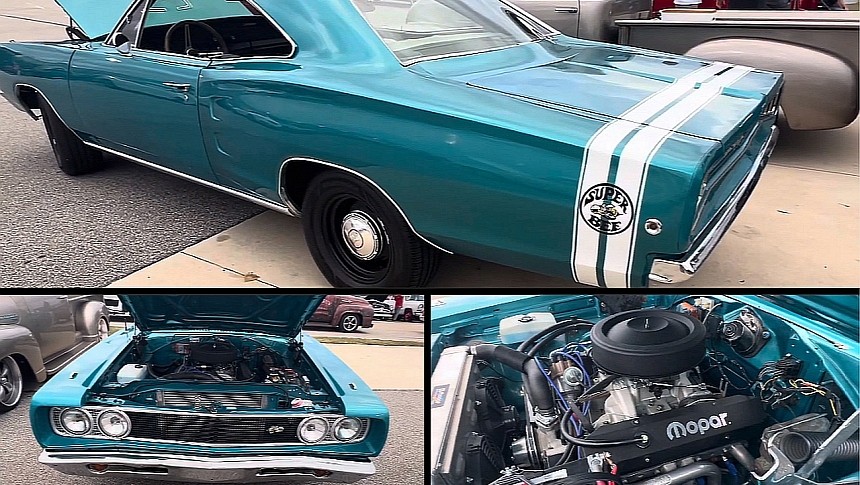Introduced for the 1968 model year, the Super Bee was Dodge's most affordable muscle car until it was discontinued at the end of 1971. But despite its low sticker, it was less popular than its corporate twin, the Plymouth Road Runner. While the latter moved nearly 176,000 units through 1971, the Super Bee found only 56,202 customers.
A slow seller compared to the Road Runner, the Super Bee is still a relatively common classic. Granted, the 426 HEMI cars are rare and expensive nowadays, but 383-equipped examples regularly appear at car events. And sadly enough, thousands of them are still waiting to be rescued in junkyards and barns.
The final-year 1971 Super Bee is arguably the rarest, regardless of the engine. The Charger-based muscle car sold only 5,054 units during what many consider the last year for high-performance American classics. As far as the B-body Super Bee is concerned, the 1968 variant stands out as the scarcest.
Dodge delivered 7,842 vehicles that year, including 125 HEMI-equipped examples. This leaves 7,717 383-powered rigs out there, which is a fairly low number given the low survival rate of these muscle cars. The turquoise example you see here may look like a 1968 Super Bee at first glance, but it's actually a clone. Not only because it features a V8 that Dodge did not offer in the 1968 version, but also because this car is a hardtop.
Unlike the Road Runner, the Super Bee never got a hardtop version. The nameplate was restricted to the coupe body style, which came with a B-pillar post. So what is hiding behind this imprersonator? It's mostly likely a 1968 Coronet, on which the Super Bee was based. As for what's under the hood, the 440-cubic-inch (7.2-liter) you see here wasn't available in the Super Bee until 1969.
It's unclear whether the RB is a period-correct unit or not, but the engine bay seems packed with modern performance features. So even though it might be a golden-era 440, it should be notably more potent than the average RB. In fact, I'm pretty sure this massive lump cranks out more oomph than the 426 HEMI, which came with 425 horsepower on tap.
It's the kind of badge and engine swap that may upset diehard enthusiasts who worship numbers-matching Mopars, but I think it really depends on how you look at it. If this Coronet was rescued from a barn in poor condition and without a drivetrain, it's the perfect solution to put it back on the road.
At the same time, I can't ignore how good this build looks. Sure, it's far from perfect as far as authentic details go, but the turquoise paint looks brilliant, and it's actually a period-correct hue. Moreover, the interior flaunts a two-tone white/black combo that works great with the bright exterior. It also includes goodies like a four-speed manual with a pistol-grip shifter and a bench seat.
Granted, I would have loved a set of matching wheels, too, but I'm just nitpicking at this point. This Mopar is what all barn finds hope to become, and I bet you'll fall in love with it as soon as you hit the play button below.
The final-year 1971 Super Bee is arguably the rarest, regardless of the engine. The Charger-based muscle car sold only 5,054 units during what many consider the last year for high-performance American classics. As far as the B-body Super Bee is concerned, the 1968 variant stands out as the scarcest.
Dodge delivered 7,842 vehicles that year, including 125 HEMI-equipped examples. This leaves 7,717 383-powered rigs out there, which is a fairly low number given the low survival rate of these muscle cars. The turquoise example you see here may look like a 1968 Super Bee at first glance, but it's actually a clone. Not only because it features a V8 that Dodge did not offer in the 1968 version, but also because this car is a hardtop.
Unlike the Road Runner, the Super Bee never got a hardtop version. The nameplate was restricted to the coupe body style, which came with a B-pillar post. So what is hiding behind this imprersonator? It's mostly likely a 1968 Coronet, on which the Super Bee was based. As for what's under the hood, the 440-cubic-inch (7.2-liter) you see here wasn't available in the Super Bee until 1969.
It's unclear whether the RB is a period-correct unit or not, but the engine bay seems packed with modern performance features. So even though it might be a golden-era 440, it should be notably more potent than the average RB. In fact, I'm pretty sure this massive lump cranks out more oomph than the 426 HEMI, which came with 425 horsepower on tap.
It's the kind of badge and engine swap that may upset diehard enthusiasts who worship numbers-matching Mopars, but I think it really depends on how you look at it. If this Coronet was rescued from a barn in poor condition and without a drivetrain, it's the perfect solution to put it back on the road.
At the same time, I can't ignore how good this build looks. Sure, it's far from perfect as far as authentic details go, but the turquoise paint looks brilliant, and it's actually a period-correct hue. Moreover, the interior flaunts a two-tone white/black combo that works great with the bright exterior. It also includes goodies like a four-speed manual with a pistol-grip shifter and a bench seat.
Granted, I would have loved a set of matching wheels, too, but I'm just nitpicking at this point. This Mopar is what all barn finds hope to become, and I bet you'll fall in love with it as soon as you hit the play button below.













